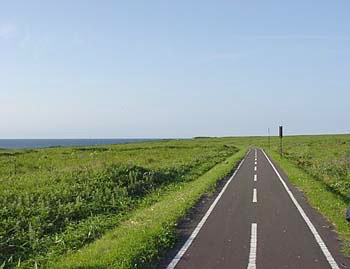































Risshiri's main claim to fame is Risshiri-zan, or "Risshiri Fuji" - a mountain that resembles Mt. Fuji most in the way it seems to rise straight up out of nowhere. Climbing the mountain is the main activity for visitors to the island, but on this first day I opted to circle the island on my bicycle, partly to confirm my first impression that, although beautiful, it is nowhere near as other-worldly as its neighbor Rebun. I was wrong: the sight of the mountain reflected in the pond near the island's southernmost tip is certainly more typical of the U. S. or Canada than Japan.
For cyclists, however, the bikepath is a very pleasant way to see a lot of the island - away from the cars and tour buses, in the silence that does the scenery the most justice. In one area in the northwestern section, the bikepath passes directly through what appears to be a bird breeding ground. The end result is like something out of a Hitchcock movie: you cycle directly through hundreds of squawking seabirds that move out of your way only reluctantly. Incidentally, along the way I learned the answer to the teepee question posed on Day 4. The wooden boards were used in the past for drying nishin (herring). Nowadays apparently a different technique is used. So since people have no use for the wood now, particularly since most have switched to kerosene instead of wood-burning heaters, they just stack the wood in their yards.



